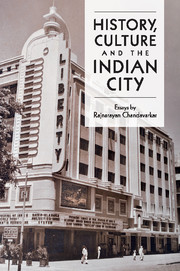Book contents
- Frontmatter
- Contents
- Acknowledgements
- Publisher's note
- Introduction by Dr Jennifer Davis, Wolfson College, University of Cambridge
- Bombay's perennial modernities
- Sewers
- Peasants and proletarians in Bombay city in the late nineteenth and early twentieth centuries
- State and society in colonial India
- Religion and nationalism in India
- From neighbourhood to nation: the rise and fall of the Left in Bombay's Girangaon in the twentieth century
- Historians and the nation
- Urban history and urban anthropology in South Asia
- Aspects of the historiography of labour in India
- Postscript by Professor David Washbrook, Trinity College, University of Cambridge
- Bibliography of the published works of Rajnarayan Chandavarkar
- Index
Bombay's perennial modernities
Published online by Cambridge University Press: 17 March 2010
- Frontmatter
- Contents
- Acknowledgements
- Publisher's note
- Introduction by Dr Jennifer Davis, Wolfson College, University of Cambridge
- Bombay's perennial modernities
- Sewers
- Peasants and proletarians in Bombay city in the late nineteenth and early twentieth centuries
- State and society in colonial India
- Religion and nationalism in India
- From neighbourhood to nation: the rise and fall of the Left in Bombay's Girangaon in the twentieth century
- Historians and the nation
- Urban history and urban anthropology in South Asia
- Aspects of the historiography of labour in India
- Postscript by Professor David Washbrook, Trinity College, University of Cambridge
- Bibliography of the published works of Rajnarayan Chandavarkar
- Index
Summary
From its inception, Bombay bore the markers of its modernity. Unlike most towns in India, perhaps anywhere, it did not develop at first out of its role as a seat of power or as a centre of administration. Nor did it emerge as a market, organically linked to its hinterland. Its origins lay in a tawdry settlement by a Europe poised on the cusp of modernity. In 1661, the Portuguese crown granted it to the British as part of Charles II's dowry when he married Catherine of Braganza. At the time, it consisted of a cluster of small islands, sparsely inhabited, if at all, off the west coast of India. It is doubtful whether the Mughals, pushing south in search of revenues, Shivaji seeking to improve his authority of the Deccan or any of the regional satraps of the subcontinent were aware of its existence. The gloss of modernity soon faded. The Crown quickly transferred its worthless possession to the East India Company. The Company over the next century duly considered abandoning it on several occasions. By the 1730s, the Company's factors, subordinated by Indian merchants in the trade of the much more prosperous port of Surat, recognized that they could use Bombay's natural harbour to build ships and deploy them to protect their consignments from ‘pirates’ in the Indian Ocean.
- Type
- Chapter
- Information
- History, Culture and the Indian City , pp. 12 - 30Publisher: Cambridge University PressPrint publication year: 2009



